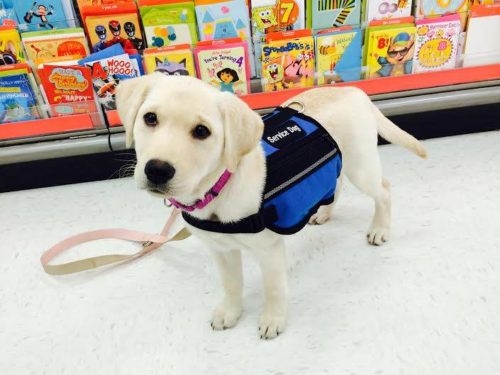Staff editorial- Barking up the right tree
Where should the limits of therapy dogs be?

This puppy is in training for those who have PTSD.
A therapy dog’s main purpose is to serve their owner in every way they are trained to. But what happens when their dog can’t be there when they’re needed most? There are times in people’s lives when a dog’s service can be the reason they don’t end up with a hefty hospital bill. There are some cases in which people view dogs in certain places to be inappropriate to the situation; however, they may not see the same view as those who actually need them.
For those who love dogs, seeing one sitting in a restaurant may be a joy, but there are people who see it as the opposite. Therapy dogs are trained and given a license to provide the service needed for their owner. They have a job when their therapy service dog vest is on and many know this. In cases such as a dog is sitting beneath a dinner table at a restaurant, not causing any disruption, most wouldn’t see this as a problem.
Some may wonder if the dog’s attention could be diverted by someone trying to give the dog attention. When the dog is trained, its mind is set to help their owner in every way they’re supposed to. If the animal is unable to achieve this goal, then they don’t receive the license to take the dog anywhere needed.
Therapy dogs, just like any other working dogs, have their job set for themselves. When the harness is put on and they walk out the door, they’re working and doing their job. There are strict rules in many stores, restaurants or schools. Many places have a strict dog/pet policy that could be due to many reasons. Two very large issues are considered by the administrators: what if someone has an allergy and could this disrupt others?
In a school setting, there are numerous reasons as to why or why not service dogs should be welcomed. In cases that a student has epilepsy and their dog can detect a seizure coming, what would be the problem of having the animal around? Some may say it could be a distraction to others, but these dogs are trained for the purpose to keep to themselves and not bother others.
If a student-along with a guardian-can provide a certified license and reasonable cause to why their therapy is needed, then where is the problem? These are strictly trained dogs who serve one purpose to their owners and no one else. Schools should consider how having therapy dogs in a school setting could have a positive impact on the students and their schoolwork. There are reasons these dogs exist; having them around for those who need them would improve many lives in a setting like school.


